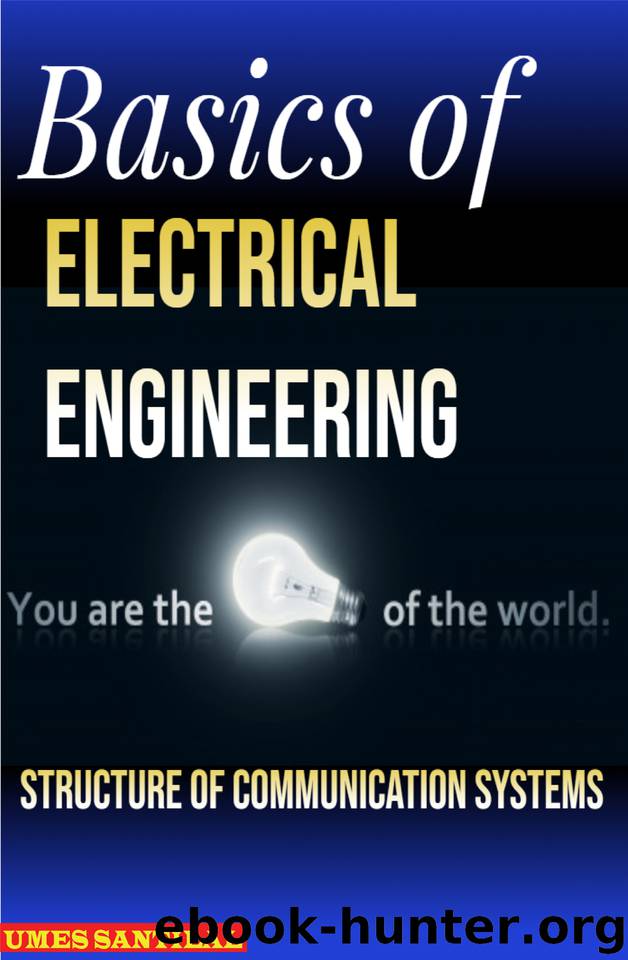Basics of Electrical Engineering: Structure of Communication Systems by SANTILAL UMES

Author:SANTILAL, UMES [SANTILAL, UMES]
Language: eng
Format: epub
Published: 2020-03-28T16:00:00+00:00
b)
j2j
c)
jjj
Issue 2.4: Complex-esteemed Signals
Complex numbers and phasors assume a significant job in electrical designing. Comprehending frameworks for complex exponentials is a lot simpler than for sinusoids, and straight frameworks investigation is especially simple.
a)
Find the phasor portrayal for each, and re-express each as the genuine and fanciful pieces of acomplex exponential. What is the recurrence (in Hz) of each? When all is said in done, are your answers one of a kind?
Assuming this is the case, demonstrate it; if not, nd an elective response for the intricate exponential portrayal. I) 3sin(24t)
ii) iii)
b)
Show that for direct frameworks having genuine esteemed yields for genuine information sources, that when the info is thereal part of an unpredictable exponential, the yield is the genuine piece of the
framework's yield to the mind boggling exponential (see Figure 2.17).
S Re
Figure 2.17
Issue 2.5:
For every one of the showed voltages, compose it as the genuine piece of an unpredictable exponential (v (t) = Re(V
est)). Expressly show the estimation of the mind boggling plentifulness V and the perplexing recurrence s. Speak to every mind boggling abundancy as a vector in the V -
plane, and demonstrate the area of the frequencies in the intricate s-plane.
a) v (t) = cos(5t)
b)
c) v (t) = e−t
d)
e)
v (t) = 5e(2t) sin(8t + 2π)
f)
v (t) = −2
g)
v (t) = 4sin(2t) + 3cos(2t)
h)
Issue 2.6:
Express every one of the accompanying signs (Figure 2.18) as a straight mix of deferred and weighted advance capacities and slopes (the fundamental of a stage).
1
1
2
(a)
(b)
(c)
(d)
(e)
Figure 2.18
Issue 2.7: Linear, Time-Invariant Systems At the point when the contribution to a straight, time-invariant framework is the sign x(t), the yield is the sign y (t) (Figure 2.19).
a)
Find and sketch this current framework's yield when the info is the delineated sign (Figure 2.20).
b)
Find and sketch this current framework's yield when the information is a unit step.
Figure 2.19
Figure 2.20
Issue 2.8: Linear Systems
The delineated info (Figure 2.21) x(t) to a straight, time-invariant framework yields the yield y (t).
Figure 2.21
a)
What is the framework's yield to a unit step input u(t)?
b)
What will the yield be the point at which the information is the portrayed square wave (Figure 2.22)?
Figure 2.22
Issue 2.9: Communication Channel An especially intriguing correspondence channel can be demonstrated as a straight, time-invariant framework. At the point when the transmitted sign x(t) is a heartbeat, the got signal r (t) is as appeared (Figure 2.23).
Figure 2.23
a)
What will be the gotten signal when the transmitter sends the beat succession (Figure 2.24) x1 (t)?
b)
What will be the gotten signal when the transmitter imparts the beat sign (Figure 2.24) x2 (t) that has a large portion of the term as the first?
Figure 2.24
Answers for Exercises in Chapter 2
Answer for Exercise 2.1 (p. 14) z + z∗= a + jb + a −jb = 2a =
2Re(z). Likewise, z −z∗= a + jb − (a −jb) = 2jb = 2jIm(z) Answer for Exercise 2.2 (p. 15)
To change over 3−2j to polar structure, we rst find the number in the intricate plane in the fourth quadrant. The
√ q 2 + (−2)2. The good ways from the starting
Download
This site does not store any files on its server. We only index and link to content provided by other sites. Please contact the content providers to delete copyright contents if any and email us, we'll remove relevant links or contents immediately.
Whiskies Galore by Ian Buxton(41935)
Introduction to Aircraft Design (Cambridge Aerospace Series) by John P. Fielding(33085)
Small Unmanned Fixed-wing Aircraft Design by Andrew J. Keane Andras Sobester James P. Scanlan & András Sóbester & James P. Scanlan(32763)
Craft Beer for the Homebrewer by Michael Agnew(18193)
Turbulence by E. J. Noyes(7977)
The Complete Stick Figure Physics Tutorials by Allen Sarah(7334)
Kaplan MCAT General Chemistry Review by Kaplan(6896)
The Thirst by Nesbo Jo(6876)
Bad Blood by John Carreyrou(6580)
Modelling of Convective Heat and Mass Transfer in Rotating Flows by Igor V. Shevchuk(6406)
Learning SQL by Alan Beaulieu(6235)
Weapons of Math Destruction by Cathy O'Neil(6205)
Man-made Catastrophes and Risk Information Concealment by Dmitry Chernov & Didier Sornette(5951)
Digital Minimalism by Cal Newport;(5698)
Life 3.0: Being Human in the Age of Artificial Intelligence by Tegmark Max(5506)
iGen by Jean M. Twenge(5384)
Secrets of Antigravity Propulsion: Tesla, UFOs, and Classified Aerospace Technology by Ph.D. Paul A. Laviolette(5330)
Design of Trajectory Optimization Approach for Space Maneuver Vehicle Skip Entry Problems by Runqi Chai & Al Savvaris & Antonios Tsourdos & Senchun Chai(5036)
Pale Blue Dot by Carl Sagan(4949)
